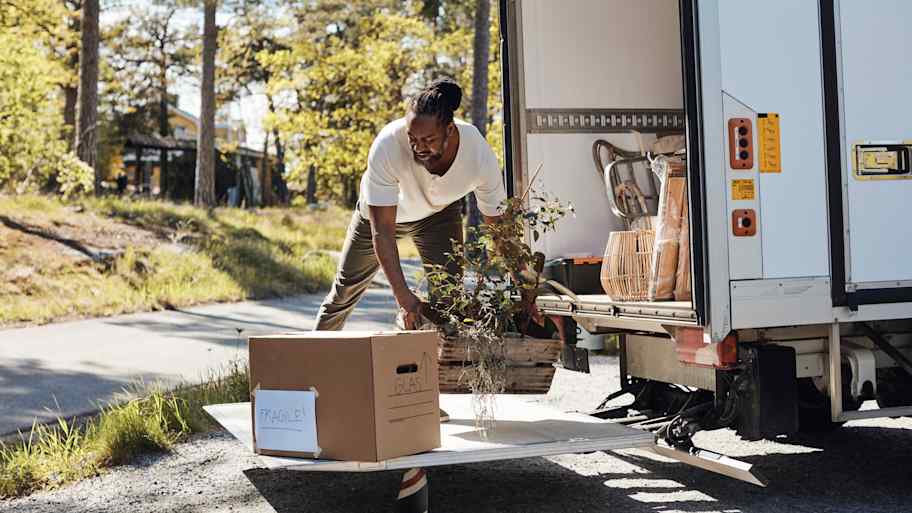
Whether you need to ship a moving container overseas or domestically, you can expect to pay several thousands of dollars. Learn more using our cost guide.
The right sized moving boxes make for a smooth move


You wouldn’t be the first person so occupied by the chaos of moving that it didn’t cross your mind to dive into the pros and cons of moving boxes. Packing seems like the no-brainer part of moving, but it helps to know which sizes work best for your things before hitting the store or starting a search for recycled boxes. So before layering the bubble wrap and unrolling the packing tape, take a minute to learn the four keys to choosing the right moving boxes.
It's not really about where you get your boxes; it’s about the quality of the boxes you can find. Of course, buying directly from a local moving company is the ultimate in box-buying luxury, but you’re going to pay premium prices.
You can also buy from home improvement and hardware stores, but they’re still pricey, about $70 for a bundle of 20 medium-sized boxes. If you pack as you should, your final shipment could easily reach hundreds of boxes. That’s a lot of costly cardboard.
For a budget-friendly move, try to use a mix of boxes: new ones for the most precious items, plus an assortment of recycled boxes from various stores and online marketplaces. You might have to try a couple of different stores because corporate policies vary on sharing boxes with the public. Take a look at a few of the most popular places to find free and used boxes.
Buy Nothing Project groups
The Freecycle Network
Nextdoor
Facebook Marketplace
Craigslist
Neighborhood groups
Grocery store
Beer, wine, and liquor stores
Department stores
Home improvement stores
Popular big-box stores
And, of course, don't forget about your online shopping habit. Some of the boxes might work if you shore up their strength with extra packing tape. Remember to save all the packing materials inside; they’ll come in handy later.

Don’t be tempted to find the most oversized boxes and fill them with as much as possible to save money and time, but you’ll ultimately end up with a lot of broken treasures. Instead, use these packing tips to get you started.
Limit the box weight to 40 pounds or risk burst seams.
Don’t underfill boxes, or they’ll crush if another box sits on top.
Heavy items go in small boxes, and light items go in big boxes.
Now, let’s take a look at the best sizes and how many moving boxes you’ll need. First, here’s the BLUF: you’re going to need a lot of medium-sized boxes; they’re the most versatile.
Extra small (15 by 12 by 10 inches): Collectibles, books, and tools
Small (16 by 12 by 12 inches): Glass and dishware, books, canned food, small appliances
Medium (18 by 18 by 15 inches or 22 by 16 by 15 inches): Toys, home decor, photo albums, office supplies, most household items
Large (18 by 18 by 24 inches): Pillows, bedding, linens, large serve ware, lamps, vases
Extra-large (22 by 22 by 21.5 inches): Decorative furniture pillows, blankets, towels
Dish packs have a double layer of corrugated cardboard and sometimes dividers to protect fragile items you normally have in your kitchen.
TV boxes mimic the original TV box and have sturdier construction than standard boxes. They also usually have foam bags, bubble wrap, and pieces to protect the corners.
Wardrobe boxes come with bars to hang clothes. They’re tall and can also store accessories like shoes and purses on the bottom.
Mirror boxes are perfect for transporting fragile mirrors, and some even include corner protectors.
If you’re like most people, you probably already have plastic storage boxes in your basement or garage because they’re super handy for keeping your stuff clean and safe. Load them in the truck if they’re ready to go, but some might need filler to cut down on shifting. If you hire a moving company to drive your boxes, make sure they’ll accept plastic bins.
But, if you don't have any plastic bins yet, they could be perfect for your move. Seasonal home decorating, baby clothes and toys, keepsakes, and out-of-season clothing are all great options for plastic bins. They’re stackable, and after adding packing fillers and a layer of strong tape for good measure, they’re pretty reliable.

After you fill several boxes, go ahead and see if you can lift and carry each one. Do the contents shift? Can you hear glasses clanging? Stack a few to make sure they’ll hold weight in the moving truck. You might need to add more paper filler and packing tape. Testing a few of your boxes now helps you avoid disappointment later.
From average costs to expert advice, get all the answers you need to get your job done.

Whether you need to ship a moving container overseas or domestically, you can expect to pay several thousands of dollars. Learn more using our cost guide.

The cost to move a tiny house depends on its weight, distance, and what type of moving equipment is required. Our guide can help you budget for your move.

Planning and budgeting for an office move? Find out the average office moving costs, from moving office equipment to IT expenses.

Packing up and hauling your belongings to a new home is no easy feat, but these tips for long-distance moves will keep you on track.

Shed relocation without the hassle is possible; either to a different or new location. Discover the best professionals to safely and efficiently move your shed to its new home.

If you’re planning a big move, this checklist can help make sure you don’t forget anything. Prepare for your cross-country move with this guide.